
 Department of Conservation and Recreation
Department of Conservation and Recreation
Conserve. Protect. Enjoy.
 Department of Conservation and Recreation
Department of Conservation and Recreation
By Haley RodgersPosted November 28, 2023
Local artist Cassandra L. Kim has used her creativity to feature Virginia's rare animals and plants in a new series of surrealistic painted portraits called "Rare in Virginia." Her goal is to spread awareness of the biodiversity at risk in our state, something the Virginia Natural Heritage Program works to do daily.
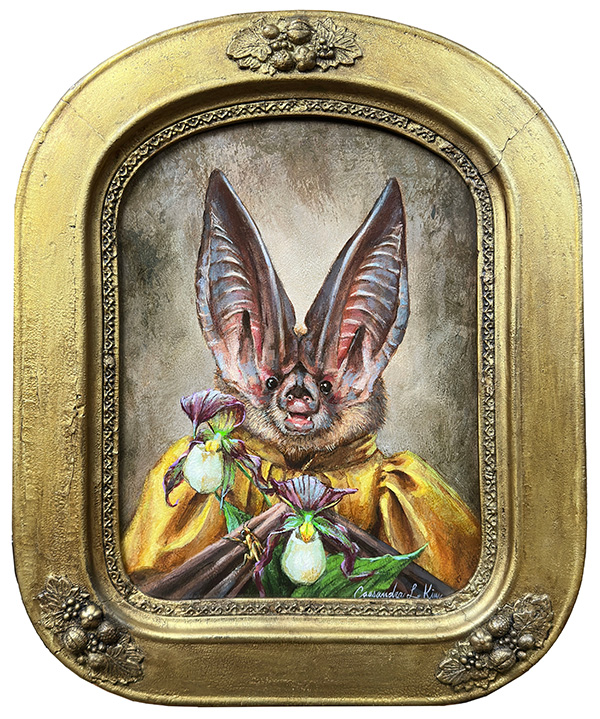 "Miss Virginia Big-Eared Bat" Acrylic and oil on ACM panel (9in. X 12in.) in a restored antique frame (14in. X 16in.) Featuring the Virginia big-eared bat, Kentucky lady's slipper and Bethany beach firefly.
"Miss Virginia Big-Eared Bat" Acrylic and oil on ACM panel (9in. X 12in.) in a restored antique frame (14in. X 16in.) Featuring the Virginia big-eared bat, Kentucky lady's slipper and Bethany beach firefly.
You can see Cassandra’s 16 "Rare in Virginia" paintings (12 acrylic and oil paintings, plus 4 ink paintings created with walnut ink Cassandra made from locally collected walnuts) on display at Glave Kocen Petite starting on December 2, 2023. Full details below.
Where: Glave Kocen Petite (111 N 18th St., Richmond, VA 23223)
When: Dec. 2-23, 2023
Hours: Tues.-Sat., noon-4 p.m.
Admission: Free
Open House with Cassandra Kim: Sat., Dec. 2, noon-4 p.m.
Gallery Talk with Cassandra Kim and Anne Chazal, DCR’s chief biologist: Sat., Dec. 9 at 10 a.m.
To gain insight into her inspirations and artistic process, we asked Cassandra a few questions.
What inspired you to focus on rare species for your subject matter?
I’m lucky to be surrounded by a lot of smart people, who helped me form the concept. This show was originally going to feature extinct animals, an idea suggested by Jenn Glave of Glave Kocen Petite. Then I was at a friend’s party when I talked to Anne Chazal, Chief Biologist of Natural Heritage, about the show idea, and she hinted that including some rare animals would be good for spreading awareness. That triggered some ideas in my brain, and I decided I only wanted to paint rare Virginian animals.
Anne also suggested I check out Natural Heritage's "Resource of Virginia for Rare Animals and Rare Plants" online, which sent me down a rabbit hole of research. It made me wonder how many species I could highlight, and that’s when I decided I wanted to challenge myself to paint not just a rare animal per piece, but to also include a rare plant and insect in each piece. The more I researched, the more I realized how much local biodiversity is currently at risk. Our state of Virginia is a beautiful place and if we don’t stop and take notice, I worry how much will disappear. I thought maybe I could use my show as an opportunity to help bring awareness to that.
Do you have favorite pieces in this collection?
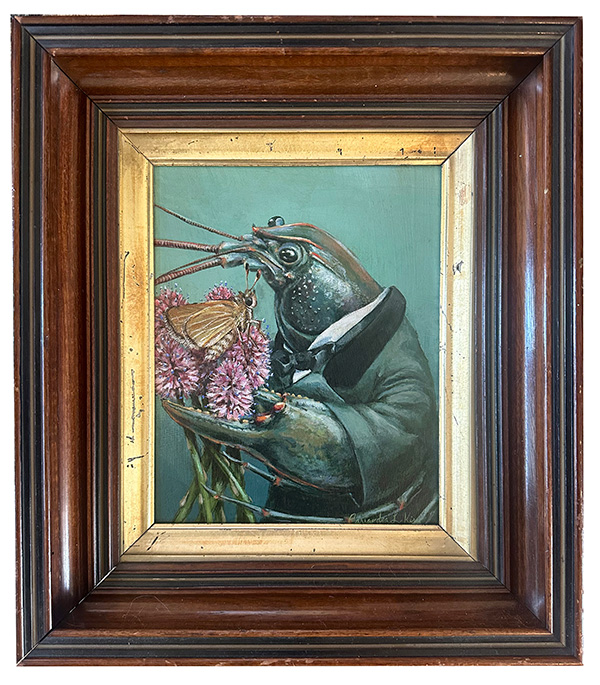 "Big Sandy Crayfish" Acrylic and oil on panel (8in. x10in.) in a restored antique frame (12in. X 14in.) Featuring the big sandy crayfish, swamp pink and arogos skipper.
"Big Sandy Crayfish" Acrylic and oil on panel (8in. x10in.) in a restored antique frame (12in. X 14in.) Featuring the big sandy crayfish, swamp pink and arogos skipper.
I love the "Big Sandy Crayfish" because it was the first one I painted in this series. I initially challenged myself with a crayfish because it seemed like it was going to be the hardest to figure out. Contemplating how a crayfish would wear a jacket and hold flowers took me a bit to work out. I really try to hold on to an animal's anatomy the best I can while dressing them in clothes. Once I had completed this piece, I got really excited to dig into creating the body of work for the show.
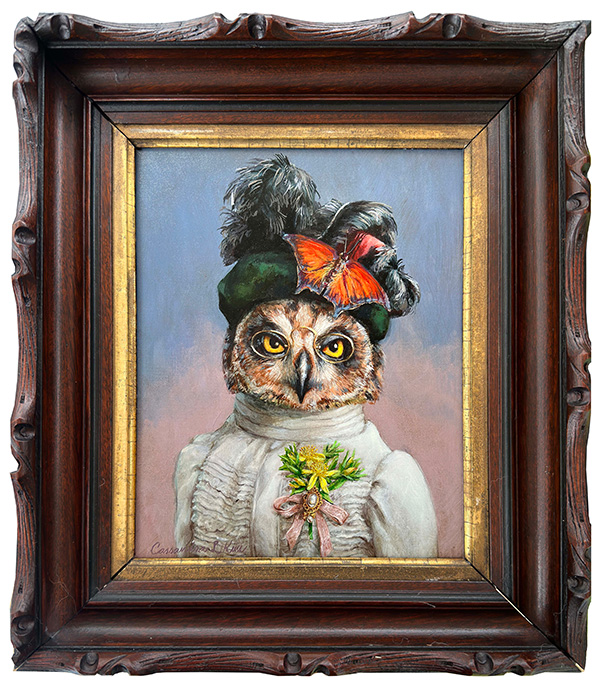 “Miss Short-Eared Owl” Acrylic and oil on ascot cotton mounted on ACM panel (8in. X 10in.) in a restored antique frame (12.5in. x 14.5in.) Featuring the short-eared owl, bog St. John’s wort and goatweed leafwing.
“Miss Short-Eared Owl” Acrylic and oil on ascot cotton mounted on ACM panel (8in. X 10in.) in a restored antique frame (12.5in. x 14.5in.) Featuring the short-eared owl, bog St. John’s wort and goatweed leafwing.
“Miss Short-Eared Owl” was the most effortless to paint. She came out with such a stern expression that I adored. I’m proud that I solved how to add the bog St. John’s wort by creating a boutonniere for her to wear. It may seem silly, but all those tiny details are the challenges that make these paintings so much fun to create.
What was your process in creating each piece? For example, what inspired the outfits and the species you paired together?
This show is a little different for me because first I needed to research Virginia’s rare and vulnerable species. After researching, I created a spreadsheet separating animals, plants and insects and started to look for images of the different species to see which ones I wanted to match up. Sometimes I paired species based on interesting similarities, like the ear of a Virginia big-eared bat reminded me of the petals of a Kentucky lady’s slipper plant. Or I would highlight the differences between animal, plant and insect with dramatic color variations because I thought it helped bring attention to the lush biodiversity, like seen in the portrait of the big sandy crayfish.
Once I had a big enough list to work from, then I moved on to finding my frames. My process probably seems a bit backwards, but before I figure out a painting, I need to have the frame. I like to use vintage and antique frames, which I repair and restore myself [click here to watch an Instagram video showing a timelapse of Cassandra restoring a frame]. Once I have the frames, I know what size to make each painting, so I can then make a detailed sketch. After I have a set sketch, I move on to my painting that I create in acrylic and oil on panel. Lastly, I do the framing myself.
For some reason when I thought of the rarity of animals it made me think of old daguerreotypes and tintype photos, almost as if they’re part of a different time. I don’t know if I can pinpoint in my brain why that seems like a natural pairing; I just knew that when I settled on my show theme, I knew it was going to be set in the Victorian-era leaning into the old photography as inspiration for the portraits.
What did you learn during this project? Any favorite fun facts on the species you featured?
I learned so much! First off, just learning how to read the charts with the global and state ranking and the vocabulary used for the levels of the scarcity of species was really interesting. Understanding the difference between extinct versus extirpated, things like that were fascinating. I now know a ton of new fun facts. My favorite one is that the wood turtle is the only reptile to use a move called the “worm stomp.” They stomp their feet and shell against the ground in such a way that it mimics the sound of rain to worms and moles underground, so they come to the surface and then the wood turtle eats them.
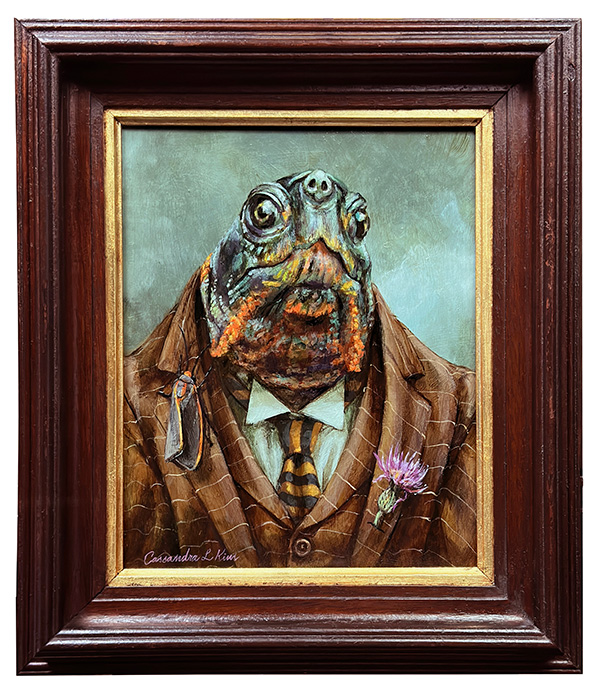 "Mr. Wood Turtle" Acrylic and oil on Masonite panel (8in. X 10in.) in a restored antique frame (12in. X 14in.) Featuring the wood turtle, Virginia thistle and yellow-edged pygarctica moth.
"Mr. Wood Turtle" Acrylic and oil on Masonite panel (8in. X 10in.) in a restored antique frame (12in. X 14in.) Featuring the wood turtle, Virginia thistle and yellow-edged pygarctica moth.
I couldn’t stop reading about Eastern cougars which are considered extirpated (meaning regionally extinct), but there are still random unconfirmed sightings almost like bigfoot. I read that the U.S. Fish and Wildlife Service has an unofficial term for an unreliable sighting. They call it a "UFO" to stand for Unidentified Fluffy Objects, because when they’ve researched such sightings, they've found them to be animals like golden retrievers, coyotes and even house cats instead.
Anything else you want to share about the "Rare in Virginia" exhibit?
I will have a calendar available for purchase that is of the paintings from the show and 10% of the proceeds will be donated to the Natural Heritage Program. It will be available for purchase at Glave Kocen Petite, Mongrel and on my website (www.cassandraloomiskim.com). Also, the show is very family friendly. I am creating an activity sheet for kids that connects with the show, so they have something fun and interactive to do in the gallery.
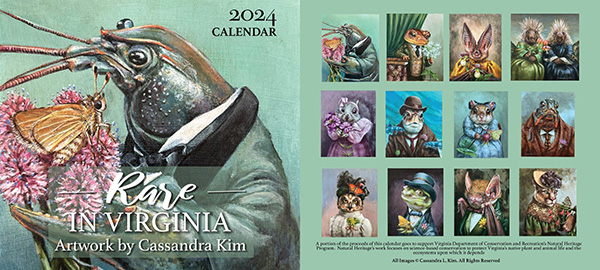
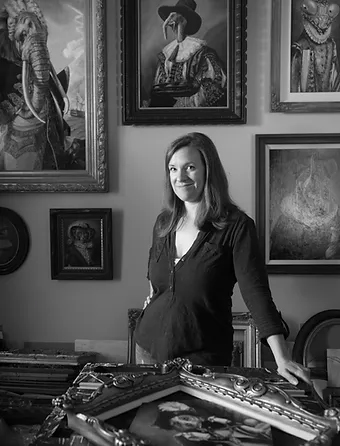
A special thank you to Cassandra for using her talents to bring light to rare species in Virginia. Click here to learn more about Cassandra L. Kim.
Categories
Natural Heritage | Nature

